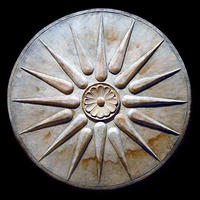You are in: Europe -> Greece -> Archaeological Site ... , and traditional search or Image Gallery will yield results of this site only
Archaeological Site of Aigai (modern name Vergina)
| Site number: | 780 |
|
| Type of site: | Cultural | |
| Date: | 11th cent. BC | |
| Date of Inscription: | 1996 | |
| Location: | Europe, Greece, Region of Central Macedonia, Prefecture of lmathia | |
Up to 75 images are shown here. Click on each for more details or on Image Gallery for more images.
| Description: | The city of Aigai, lying near Vergina, in northern Greece, is the ancient first capital of the Kingdom of Macedonia. It was discovered in the 19th century. Among the most significant remnants are the monumental palace, copiously adorned with mosaics and painted stuccoes, and the burial ground encompassing more than 300 tumuli, a number of which date from the 11th century B.C. The royal tomb of Philip II rests within the Great Tumulus; the father of Alexander, he conquered all the Greek cities, thus paving the way for his son and the expansion of the Hellenistic world. --WHMNet paraphrase from the description at WHC Site, where additional information is available. | |
| Vergina (in Greek Βεργίνα) is a small town in northern Greece, located in the prefecture of Imathia, Central Macedonia. The town became internationally famous in 1977, when the Greek archaeologist Manolis Andronikos unearthed what he claimed was the burial site of the kings of Macedon, including the tomb of Philip II, father of Alexander the Great. Vergina is about 13km south-east of the district centre of Veroia and about 80km south-west of Thessaloniki, the capital of Greek Macedonia. The town has a population of about two thousand people and stands on the foothills of Mount Pieria, at an elevation of 120m (360 ft) above sea level. --Wikipedia. Text is available under the Creative Commons Attribution-ShareAlike License. | ||
| Source: | http://whc.unesco.org/en/list/780 | |
| Reference: | 1. UNESCO World Heritage Center, Site Page. | |



















